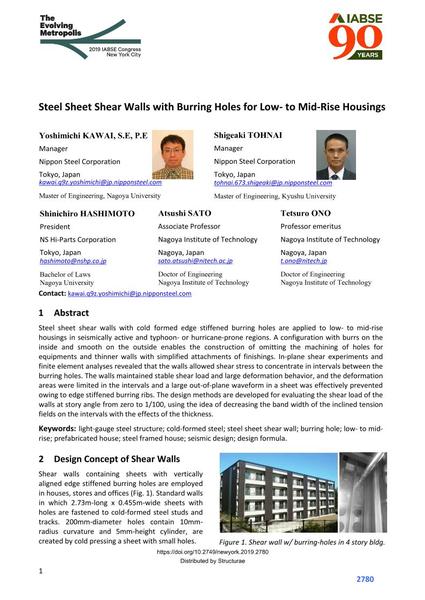Steel Sheet Shear Walls with Burring Holes for Low- to Mid-Rise Housings

|
|
|||||||||||
Détails bibliographiques
| Auteur(s): |
Yoshimichi Kawai
(Nippon Steel Corporation)
Shigeaki Tohnai (Nippon Steel Corporation) Shinichiro Hashimoto (NS Hi-Parts Corporation) Atsushi Sato (Nagoya Institute of Technology) Tetsuro Ono (Nagoya Institute of Technology) |
||||
|---|---|---|---|---|---|
| Médium: | papier de conférence | ||||
| Langue(s): | anglais | ||||
| Conférence: | IABSE Congress: The Evolving Metropolis, New York, NY, USA, 4-6 September 2019 | ||||
| Publié dans: | The Evolving Metropolis | ||||
|
|||||
| Page(s): | 2780-2786 | ||||
| Nombre total de pages (du PDF): | 7 | ||||
| DOI: | 10.2749/newyork.2019.2780 | ||||
| Abstrait: |
Steel sheet shear walls with cold formed edge stiffened burring holes are applied to low- to mid-rise housings in seismically active and typhoon- or hurricane-prone regions. A configuration with burrs on the inside and smooth on the outside enables the construction of omitting the machining of holes for equipments and thinner walls with simplified attachments of finishings. In-plane shear experiments and finite element analyses revealed that the walls allowed shear stress to concentrate in intervals between the burring holes. The walls maintained stable shear load and large deformation behavior, and the deformation areas were limited in the intervals and a large out-of-plane waveform in a sheet was effectively prevented owing to edge stiffened burring ribs. The design methods are developed for evaluating the shear load of the walls at story angle from zero to 1/100, using the idea of decreasing the band width of the inclined tension fields on the intervals with the effects of the thickness. |
||||
| Mots-clé: |
conception sismique
|
||||
